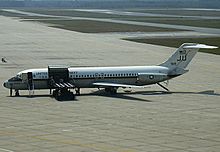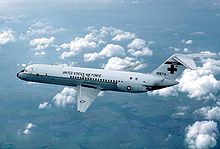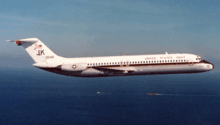- McDonnell Douglas C-9
-
C-9 Nightingale/Skytrain II USAF C-9 Nightingale in 1968 Role Jet transport National origin United States Manufacturer McDonnell Douglas Introduction 1968 Retired September 2005 (USAF C-9A) Status Retired / Active (C-9B) Primary users United States Air Force
United States NavyNumber built 48 Developed from McDonnell Douglas DC-9 The McDonnell Douglas C-9 is a military version of the DC-9 airliner. It was produced as the C-9A Nightingale for the United States Air Force, and the C-9B Skytrain II for the U.S. Naval Reserve and Marine Corps. The final active-duty flight of the C-9A Nightingale was in September 2005.[1] The Boeing C-40 Clipper is replacing the Navy Reserve's aging C-9B fleet.[2][3]
Contents
Design and development
In 1966 the US Air Force identified a need for an aeromedical transport aircraft. The following year the Air Force ordered C-9A Nightingale aircraft. Deliveries began in 1968.[4] The C-9As were used for medical evacuation (MedEvac), passenger transportation, and special missions from 1968 to 2005. The original C9A aircraft delivered to the 375th AAW at Scott Air Force Base was named after Florence Nightengale in her honor by LT Col. Mary Ann Tonne, chief nurse, 375th AAW 1968.
After selecting a modified DC-9 for passenger and cargo transport, the U.S. Navy ordered its first five C-9Bs in April 1972.[4] The C-9B aircraft have provided cargo and passenger transportation as well as forward deployed air logistics support for the Navy and Marine Corps. A C-9B was also chosen by NASA for reduced gravity research,[5] replacing the aging KC-135 Vomit Comet.
Many of the Navy's C-9Bs have a higher maximum gross take-off weight (114,000 lb or 52,000 kg) and are fitted with auxiliary fuel tanks installed in the lower cargo hold to augment the aircraft's range to nearly 2,600 nautical miles (4,200 km) for overseas missions along with tail mounted infra-red (IR) scramblers to counter heat seeking missile threats in hostile environments.
 A C-9 Skytrain II offloading on the ramp at Naval Air Station Brunswick.
A C-9 Skytrain II offloading on the ramp at Naval Air Station Brunswick.
The C-9 fleet was located throughout the continental U.S., Europe, and Asia.[6]
Variants
- C-9A Nightingale - 23 aeromedical evacuation aircraft for the United States Air Force received from 1968.[7]
- C-9B Skytrain II - 24 convertible passenger/transport versions for the United States Navy and Marine Corps delivered from 1973 to 1976. An additional five C-9s were converted from passenger configured DC-9s.[7]
- VC-9C - 3 executive transport aircraft for the United States Air Force.[7] Three aircraft (73-1681, 73-1682, 73-1683) were delivered to the US Air Force in late 1976.
- C-9K - 2 aircraft for the Kuwait Air Force.[7]
Operators
Specifications (C-9B)
Data from Encyclopedia of World Air Power[4]
General characteristics
- Crew: 5 to 8
- Length: 119 ft 3 in (36.36 m)
- Wingspan: 93 ft 5 in (28.42 m)
- Height: 27 ft 6 in (8.38 m)
- Wing area: 1,001 ft² (92.97 m²)
- Empty weight: 59,700 lb (27,080 kg -->)
- Max takeoff weight: 110,000 lb (49,900 kg)
- Powerplant: 2 × Pratt & Whitney JT8D-9 turbofan, 14,500 lbf (64.5 kN) each
Performance
- Maximum speed: Mach 0.84 (576 mph, 927 km/h)
- Cruise speed: 504 mph (485 knots, 811 km/h)
- Range: 2,900 mi (4,700 km)
- Service ceiling: 37,000 ft (11,000 m)
- Rate of climb: 3,000+ ft/min (900+ m/min)
See also
- Related development
- Aircraft of comparable role, configuration and era
- Related lists
- List of active United States military aircraft
- List of military aircraft of the United States
- List of military transport aircraft
References
- ^ "Historic C-9 heads to Andrews for retirement". US Air Force, 24 September 2005.
- ^ C-40A Clipper history page. US Navy, 16 November 2000.
- ^ "C-9B Skytrain II Completes 30 years of Continuous Fleet Support". US Navy, 2 June 2003.
- ^ a b c Gunston, Bill, ed. The Encyclopedia of World Air Power. New York, NY: Crescent Books, 1986. ISBN 0-517-49969-X.
- ^ The History of C-9B Reduced Gravity Research Program. NASA/JSC, March 25, 2008
- ^ C-9 Skytrain fact file. US Navy, 15 April 2005.
- ^ a b c d Becher, Thomas. Douglas Twinjets, DC-9, MD-90, MD-90 and Boeing 717, pp. 170-176, Crowood Press, Aviation Series, 2002. ISBN 1-86126-446-1.
External links
- C-9 Skytrain fact file and C-9 history page on U.S. Navy site
- C-9 Nightingale page and C-9 Nightingale/Skytrain pages on U.S. Air Force site
- C-9 Nightingale/Skytrain GlobalSecurity.org
- "Goodbye to an era", deploymentlink.osd.mil, Fall 2003
Douglas military aircraft Fighters Ground attack Naval bombers
and attack aircraftBombers Observation Patrol PD · P2D · P3D
Reconnaisance Transports C-1 · C-21 · C-32 · C-33 · YC-34 · C-38 · C-39 · C-41 · C-41A · C-42 · C-47 · C-48 · C-49 · C-50 · C-51 · C-52 · C-53 · C-54 · C-58 · UC-67 · C-68 · C-74 · C-84 · C-110 · XC-112/YC-112 · XC-114 · YC-116 · C-117 · C-118 · C-124 · YC-129 · C-133 · XCG-17
C-9 · C-24
RD · R2D · R3D · R4D (R4D-2 & R4D-4) · R5D · JD · R6D
CC-129 · Dakota I/III/IV · Dakota II · LXD1 · PD.808 · Skymaster ITraining aircraft Experimental McDonnell and McDonnell Douglas military aircraft and spacecraft Fighters USAAF/US Air ForceUS Navy/USMCExportLicensedAttack US Navy/USMCTrainers US NavyTransports US Air ForceUS NavyC-9
LicensedHelicopters US Army/US Air ForceUS NavyXHJH · XHCH · XHRH
ExportDrones (UAVs) US NavyKDH
Experimental US Army/US Air ForceXV-1 · X-36 · F-15 STOL/MTD · Bird of Prey
Spacecraft NASAUS Air ForceUnited States tri-service transport designations post-1962 C-1 · C-2 · C-3 · C-4 · C-5 · C-6 · C-7 · C-8 · C-9 · KC-10 · C-11 · C-12 · (C-13 not assigned) • C-14 · C-15 · (C-16 not assigned) • C-17 · C-18 · C-19 · C-20A/B/C/D · C-20F/G/H · C-21 · C-22 · C-23 · C-24 · C-25 · C-26 · C-27 / C-27J · C-28 · C-29 · (C-30 not assigned) • C-31 · C-32 · C-33 · C-35 · (C-36 not assigned) • C-37 · C-38 · C-40 · C-41 · (C-42 to C-44 not assigned) • KC-45 • KC-46
Lists relating to aviation General Aircraft (manufacturers) · Aircraft engines (manufacturers) · Airlines (defunct) · Airports · Civil authorities · Museums · Registration prefixes · Rotorcraft (manufacturers) · TimelineMilitary Accidents/incidents Records Categories:- McDonnell Douglas aircraft
- United States military transport aircraft 1960–1969
Wikimedia Foundation. 2010.





